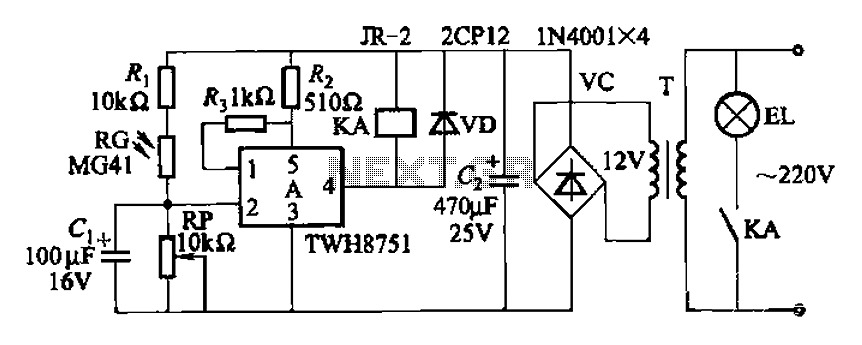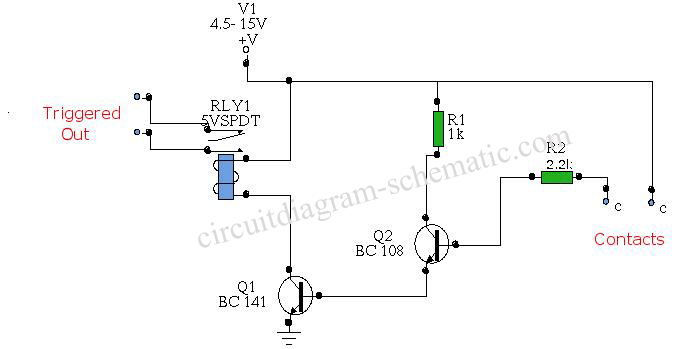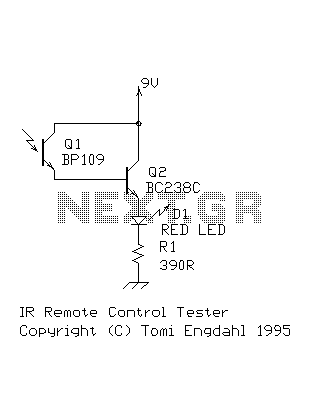
Electronic lark sounds circuit

The electronic circuit simulates bird sounds under varying lighting conditions, particularly influenced by neon light irradiation, resulting in fluctuating and changing tones. The sound produced is continuously variable. The schematic of this circuit is provided.
The described electronic circuit utilizes a sound synthesis approach to emulate the vocalizations of birds, responding dynamically to ambient lighting changes. The core component of this circuit is a microcontroller or sound generator IC, which is programmed to produce different sound patterns resembling various bird calls. The microcontroller receives input from a light sensor, such as a phototransistor or a light-dependent resistor (LDR), that detects the intensity and type of ambient light, particularly neon lighting.
As the light intensity varies, the microcontroller processes this information and adjusts the output sound frequency and modulation accordingly. This results in a range of tones that mimic the natural variability of bird sounds, creating an engaging auditory experience. The circuit may include additional components such as capacitors for filtering, resistors for biasing, and possibly a digital-to-analog converter (DAC) if high-fidelity sound reproduction is required.
Power supply considerations are also essential, as the circuit must operate efficiently under varying conditions. A regulated power supply, possibly utilizing a battery or an AC adapter, ensures stable operation of the microcontroller and sound output components.
The schematic diagram of this circuit should clearly illustrate the connections between the light sensor, microcontroller, sound output module (such as a speaker or piezo buzzer), and the power supply. Proper grounding and decoupling capacitors should be included to minimize noise and ensure reliable operation.The electronic circuit birds under different lighting, especially in the vagaries of the neon light irradiation, can be issued fluctuated, changing tone sound of birds, the sound is constantly changing. Its circuit is shown.
The described electronic circuit utilizes a sound synthesis approach to emulate the vocalizations of birds, responding dynamically to ambient lighting changes. The core component of this circuit is a microcontroller or sound generator IC, which is programmed to produce different sound patterns resembling various bird calls. The microcontroller receives input from a light sensor, such as a phototransistor or a light-dependent resistor (LDR), that detects the intensity and type of ambient light, particularly neon lighting.
As the light intensity varies, the microcontroller processes this information and adjusts the output sound frequency and modulation accordingly. This results in a range of tones that mimic the natural variability of bird sounds, creating an engaging auditory experience. The circuit may include additional components such as capacitors for filtering, resistors for biasing, and possibly a digital-to-analog converter (DAC) if high-fidelity sound reproduction is required.
Power supply considerations are also essential, as the circuit must operate efficiently under varying conditions. A regulated power supply, possibly utilizing a battery or an AC adapter, ensures stable operation of the microcontroller and sound output components.
The schematic diagram of this circuit should clearly illustrate the connections between the light sensor, microcontroller, sound output module (such as a speaker or piezo buzzer), and the power supply. Proper grounding and decoupling capacitors should be included to minimize noise and ensure reliable operation.The electronic circuit birds under different lighting, especially in the vagaries of the neon light irradiation, can be issued fluctuated, changing tone sound of birds, the sound is constantly changing. Its circuit is shown.





